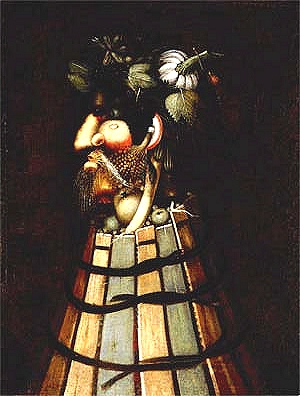 |
|
Summer and Autumn
Guiseppe Arcimboldi, 1527-1593, active in Milan,
Prague, and Vienna
Allegorical Heads Representing Summer andAutumn,
c. 1600-20
Oil on canvas
Museum purchase, 1954, SN 672 and SN673
By Sandra Musicante, March 14, 2000.
These two paintings appear to be of profiles facing each other. On closer
inspection they are composed entirely of fruits and vegetables which lose identity as
separate items to compose the features of the human face and upper body. The painting on
the left has a coat and collar made of wheat with an artichoke coming out of the chest.
His head is composed of wheat, cherries, berries and a cucumber for a nose and garlic
representing the jaw. His mouth a pea pod. The painting on the right has an apple crate
for a body with ropes tied around it. His head is made up of leaves, gourds, grapes,
orange, olives. Nuts around the mouth and an orange slice for an ear. The background is
very dark and the colors are not very bright. They are painted oil on canvas. The
difference between these two are the fruits and vegetables chosen. The one on the left are
fruits and vegetables of summer, the right autumn. And it just happens they are named -
Summer and Autumn. |
 |
|
What are these strange paintings? Certainly no other painting in this
gallery even comes close to resembling these works. These paintings were intended as
allegories on imperial rule. What you're looking at are copies. Guiseppe Arcimboldo
invented the originals. He was an artist born in Milan in the 16th Century who worked in
the Austrian Court (the Hapsburg Court) most of his life. Under Rudolph II this court was
a major European culture center and a stimulating environment. During this time the arts
and sciences existed side by side and there was great interest in nature study. Arcimboldo
painted his first series of composite heads made up from objects pertaining to the subject
of the four seasons. These paintings have numerous Hapsburg symbols, which are related to
each other according to an elaborate string of associations suggesting that as the
Hapsburg's ruled the world of states, so too they may be seen to rule over the Universe.
You could call them serious jokes. The people of the Renaissance loved paradox. They had
an appreciation for serious content presented in fanciful form.
These paintings were meant to hang together - Winter facing Spring -Summer
facing Autumn expressing a special relationship between the seasons they symbolize. Today
Arcimboldo's originals hang in the Louvre. Arcimboldo painted several series of the 4
seasons with royalty posing for some of them. These pictures were given as gifts to
relatives and dignitaries and served as advertisement for the policies of the House of
Hapsburg. It served to maintain old ties and establish new ties. These inventions made
Arcimboldo very famous and there were many copies and fakes. These was no school for this
type of painting, but the artists were inspired and the method survived into the early
20th century leading to the rise of Surrealism.
Ringling acquired these painting in 1954 and paid $4000. |